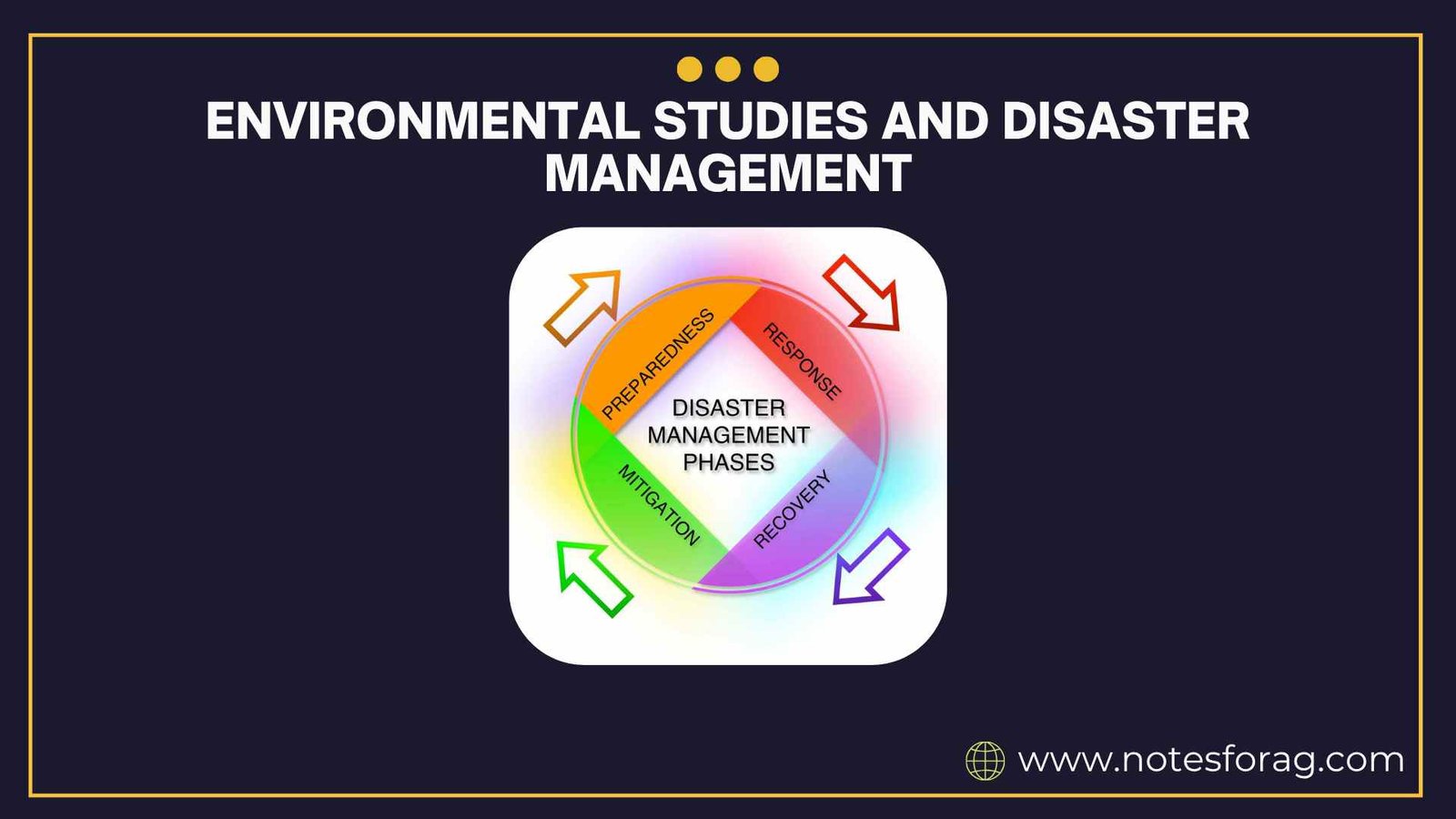Introduction
Environmental Studies and Disaster Management is a comprehensive field of study that combines the understanding of environmental systems with the processes of preparing for, responding to, and recovering from disasters. It aims to equip individuals and communities with the knowledge and tools necessary to maintain ecological balance and manage hazards effectively. This subject has gained increasing importance due to the rising frequency of environmental degradation and natural calamities, many of which are exacerbated by human actions.
Summary of Disaster Management
- Environmental studies and disaster management combine ecological knowledge with risk reduction practices. It addresses issues like pollution, climate change, and disaster phases for building resilient societies.
- The field relies on legal frameworks and institutional roles for coordinated disaster response. Tools like GIS, remote sensing, and early warnings enhance environmental monitoring and preparedness.
- Ethical values and education foster awareness, conservation, and sustainable behavior. Community participation and innovation strengthen environmental protection and disaster resilience.
Table of Contents
Understanding the Environment
What is Environment?
The environment refers to everything that surrounds us, both living (biotic) and non-living (abiotic). It includes natural elements like air, water, soil, plants, and animals, as well as human-made structures and social systems. The environment is a dynamic system, constantly changing due to natural events and human activities.
Components of the Environment
1. Biotic Components
These are the living organisms present in the environment, including humans, animals, plants, fungi, and microorganisms. They interact with each other in complex food webs and ecological relationships, contributing to the biodiversity and functioning of ecosystems.
2. Abiotic Components
Abiotic components are the non-living physical and chemical factors such as sunlight, temperature, water, air, and minerals. These elements provide the essential resources and conditions for life and significantly influence the biological processes of organisms.
Types of Environment
1. Natural Environment
This consists of physical features and ecosystems that occur without human intervention, such as forests, mountains, rivers, oceans, and wildlife habitats. The natural environment supports biodiversity and ecological processes essential for life.
2. Built Environment
The built or man-made environment includes infrastructures like buildings, roads, bridges, and cities that are developed to meet human needs. While these structures enhance living standards, they often lead to environmental challenges such as pollution and habitat destruction.
3. Social Environment
The social environment involves human interactions, cultural practices, institutions, and policies. It shapes individual behaviors and societal development and plays a key role in environmental decision-making and conservation efforts.
Importance of Environmental Studies
1. Awareness of Environmental Problems
Environmental studies educate individuals about pressing issues such as pollution, resource depletion, and climate change. Understanding these challenges is the first step toward adopting sustainable practices and encouraging environmentally responsible behavior.
2. Sustainable Development
Sustainable development seeks to balance economic growth with environmental protection. Environmental studies promote strategies that ensure resources are used wisely, ecosystems are preserved, and future generations can meet their needs.
3. Conservation of Resources
The curriculum emphasizes the efficient use of natural resources such as water, energy, and soil. By promoting conservation techniques, environmental studies aim to reduce overexploitation and maintain ecological balance.
4. Improving Quality of Life
A clean and healthy environment contributes directly to human well-being. Environmental studies focus on improving air and water quality, reducing waste, and ensuring access to green spaces, which in turn enhance physical and mental health.
Major Environmental Issues
1. Pollution
Pollution refers to the contamination of natural resources by harmful substances. Types of pollution include:
a. Air Pollution

Caused by emissions from vehicles, industries, and burning fossil fuels, air pollution leads to respiratory diseases and global warming.
b. Water Pollution
Discharge of industrial waste, sewage, and chemicals into water bodies affects aquatic life and makes water unsafe for consumption.
c. Soil Pollution
Excessive use of pesticides, dumping of industrial waste, and deforestation degrade soil quality and reduce agricultural productivity.
d. Noise Pollution
Prolonged exposure to loud sounds from traffic, construction, and industrial activities can lead to stress, hearing loss, and sleep disturbances.
2. Deforestation

The large-scale removal of trees for agriculture, urban development, or timber leads to habitat loss, reduced biodiversity, and soil erosion. Forests act as carbon sinks, and their destruction contributes to climate change.
3. Climate Change
Climate change involves significant alterations in temperature, weather patterns, and sea levels due to increased greenhouse gas emissions. It results in more frequent extreme weather events, affects crop yields, and threatens coastal communities.
4. Biodiversity Loss
Human activities such as hunting, habitat destruction, pollution, and climate change lead to the extinction of plant and animal species. Biodiversity is vital for ecological stability, and its loss weakens ecosystems’ ability to adapt and recover.
5. Waste Management
Improper disposal of solid and hazardous waste leads to land, water, and air pollution. Modern waste management practices like recycling, composting, and energy recovery are crucial to minimize environmental impacts.
Disaster Management: An Overview
What is a Disaster?
A disaster is a sudden event that causes extensive damage, loss of life, and disruption of normal activities. Disasters can be natural or man-made and often require immediate response and recovery efforts to minimize their impacts.
Types of Disasters
1. Natural Disasters
Natural disasters occur due to environmental processes and include:
- Earthquakes
- Floods
- Cyclones
- Tsunamis
- Volcanic Eruptions
- Landslides
- Droughts
2. Man-Made Disasters
These result from human negligence or malice, including:
- Industrial Accidents
- Oil Spills
- Fires
- Terrorist Attacks
- Chemical and Nuclear Explosions
Phases of Disaster Management

1. Mitigation
This involves long-term strategies to reduce the risks and impact of disasters. Examples include constructing earthquake-resistant buildings, afforestation, and land-use planning.
2. Preparedness
Preparedness includes early warning systems, evacuation plans, education, and training programs. The goal is to ensure that communities can act quickly and effectively in emergencies.
3. Response
Response refers to immediate actions taken during and after a disaster. It includes search and rescue, first aid, firefighting, and providing food and shelter to victims.
4. Recovery
The recovery phase focuses on restoring normalcy by rebuilding infrastructure, rehabilitating communities, and implementing measures to prevent future disasters.
Key Agencies in Disaster Management
1. Government Bodies
a. National Disaster Management Authority (NDMA)
The NDMA formulates policies, plans, and guidelines for disaster management in India. It coordinates relief efforts and ensures preparedness at national and state levels.
b. State and Local Authorities
Each state has its own disaster management authority that works in coordination with local bodies to address region-specific risks and emergencies.
2. NGOs and International Organizations
Organizations such as the International Red Cross, UNDP, and World Health Organization provide critical aid and expertise during disaster situations and help with post-disaster recovery.
3. Community Participation
Communities play a vital role in disaster risk reduction. Local knowledge, volunteerism, and collective action help minimize losses and enhance resilience.
Environmental Laws and Policies
1. Environmental Protection Act, 1986
This act empowers the central government to take actions to protect the environment. It serves as an umbrella legislation covering air, water, and noise pollution.
2. Forest Conservation Act, 1980
It aims to regulate the diversion of forest land for non-forest purposes and promote sustainable forest management practices.
3. Wildlife Protection Act, 1972
This act provides legal protection to endangered species and their habitats and prohibits hunting and poaching activities.
4. Disaster Management Act, 2005
It establishes the legal framework for disaster risk reduction, preparedness, and response mechanisms at all administrative levels in India.
Role of Education in Environmental and Disaster Awareness
1. School and College Curriculum
Introducing environmental studies and disaster management in educational institutions helps instill responsibility, environmental ethics, and preparedness from an early age.
2. Mass Awareness Programs
Campaigns via radio, television, social media, and public events educate the broader population about environmental conservation and disaster resilience.
3. Community Training
Organizing mock drills, safety workshops, and community emergency response training builds capacity at the grassroots level and fosters local leadership.
Technological Interventions in Environmental Management
1. Geographic Information System (GIS)
GIS is used for mapping vulnerable areas, planning evacuations, and managing land and resources efficiently.
2. Remote Sensing
Satellites provide valuable information about deforestation, weather patterns, agricultural changes, and disaster impact assessments.
3. Early Warning Systems
Weather stations, radar, and sensor networks provide timely alerts that can help prevent loss of life and property during disasters.
4. Waste Treatment Technologies
Technological solutions like incineration, composting, and bio-methanation help manage waste sustainably and reduce environmental pollution.
Sustainable Living and Environmental Ethics
1. Reduce, Reuse, Recycle
Adopting the 3Rs minimizes waste generation and conserves resources. It is a key strategy for sustainable urban and rural development.
2. Responsible Consumption
Choosing eco-friendly products, reducing energy use, and consuming responsibly help reduce the ecological footprint.
3. Conservation Ethics
Ethical considerations in environmental decisions promote fairness, intergenerational equity, and respect for all forms of life.
4. Green Innovation
Investing in renewable energy, sustainable agriculture, and clean technologies paves the way for a healthier planet.
Conclusion
Environmental Studies and Disaster Management are essential disciplines for building a safe, sustainable, and resilient future. As we face increasing environmental challenges and frequent natural disasters, education, legislation, technology, and community involvement become crucial. By fostering awareness, encouraging responsible actions, and integrating scientific knowledge with traditional practices, we can protect our environment and reduce disaster risks effectively. The responsibility lies with every individual, institution, and government to work collaboratively toward environmental conservation and disaster resilience.
Frequently Asked Questions (FAQs)
What is environmental studies and how does it relate to disaster management?
Environmental studies examine how humans interact with natural systems, addressing issues like pollution, biodiversity loss, and climate change.
Disaster management applies this knowledge to reduce vulnerability and enhance community preparedness for natural and man-made disasters.
Together, they form a framework for sustainable and risk-resilient development.
What are the four phases of disaster management?
The four stages include Mitigation (risk reduction strategies), Preparedness (planning and training), Response (emergency actions), and Recovery (rebuilding efforts).
Each phase is essential for minimizing disaster impact and ensuring quick, effective recovery. When implemented together, they create a cycle of resilience and continuous improvement.
How does technology aid in disaster and environmental protection?
Technologies like GIS and remote sensing help monitor land use, ecosystems, and vulnerable zones. Early-warning systems alert communities to approaching hazards, reducing potential losses. Modern waste-treatment methods also limit environmental pollution and improve resource efficiency.
What is ecosystem-based disaster risk reduction (Eco‑DRR)?
Eco‑DRR uses natural ecosystems such as forests, wetlands, and coral reefs to protect against floods, landslides, and storms. These natural barriers reduce disaster impact while supporting biodiversity and livelihoods. It promotes long-term resilience by integrating conservation with disaster planning.
Related Articles

